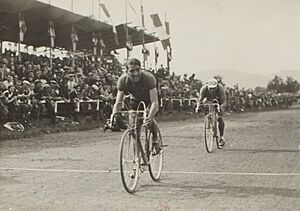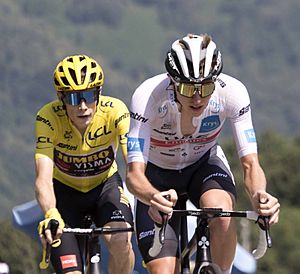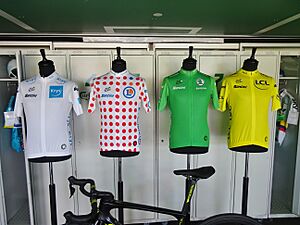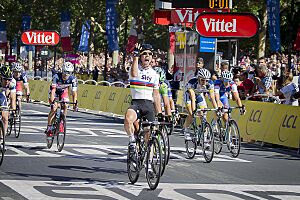Tour de France facts for kids
| Tour de France logo (black background).svg | |
| Race details | |
|---|---|
| Date | July |
| Region | France and nearby countries |
| Local name(s) | Tour de France |
| Nickname(s) | La Grande Boucle (The Big Loop) |
| Discipline | Road |
| Competition | UCI World Tour |
| Type | Grand Tour |
| Organiser | Amaury Sport Organisation |
| Race director | Christian Prudhomme |
| History | |
| First edition | 1 July 1903 |
| Editions | 112 (as of 2025) |
| First winner | |
| Most wins |
|
| Most recent | |
The Tour de France is a famous and challenging bicycle race for men held every year, mostly in France. It is the oldest and most important of the three major European races called the Grand Tours. The other two are the Giro d'Italia in Italy and the Vuelta a España in Spain.
The race first started in 1903 to help a newspaper called L'Auto sell more copies. It has happened every year since then, except during the two World Wars. Over time, the race became longer and more popular, with riders from all over the world coming to compete.
The Tour de France usually takes place in July. The route changes every year, but it always includes difficult climbs in the Pyrenees and Alps mountain ranges. For many years, the race has finished with a famous final stage on the Champs-Élysées in Paris. The race is made up of 21 daily parts, called stages, and covers about 3,500 kilometers (2,200 miles) in total.
Teams of eight riders compete to see who is the fastest. The rider with the lowest total time after all the stages is the leader and gets to wear the famous yellow jersey. There are also other competitions within the Tour, like for the best sprinter (green jersey) and the best mountain climber (polka-dot jersey).
Since 2022, there has also been a women's race called the Tour de France Femmes, which gives female cyclists their own version of this amazing event.
Contents
History of the Tour

The First Race
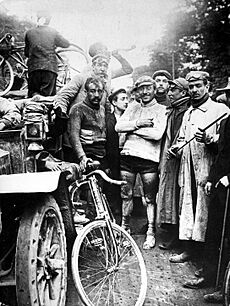
The first Tour de France was held in 1903. A French newspaper editor named Henri Desgrange wanted to create a huge bike race that would travel all around France. He hoped this exciting event would make more people buy his newspaper, L'Auto.
The first race was incredibly tough. It had only six long stages, and riders often had to cycle through the night. Only 15 cyclists originally signed up. To get more people to join, Desgrange shortened the race, lowered the entry fee, and offered prize money. This worked, and about 60 riders started the first Tour on July 1, 1903.
The winner was Maurice Garin. He dominated the race and finished almost three hours ahead of the next rider. The race was a huge success for the newspaper, and its sales doubled. The Tour de France quickly became a beloved yearly event.
Growing and Changing
The Tour grew bigger and better over the years. In 1910, the race went into the tall mountains of the Pyrenees for the first time, making it even more difficult. In 1919, the famous yellow jersey was introduced for the race leader.
For a while, riders competed for their countries in national teams. But in 1962, the race switched back to trade teams, which are sponsored by companies. This is the system that is still used today.
Over the years, many great champions have made their mark on the race. Four men have won the Tour five times: Jacques Anquetil, Eddy Merckx, Bernard Hinault, and Miguel Induráin. Their amazing achievements have helped make the Tour a legendary event.
Fair Play in the Tour
To make sure the race is fair for everyone, there are very strict rules that all riders must follow. These rules are about making sure no one gets an unfair advantage. Sometimes, riders have broken these rules.
In the past, some winners had their titles taken away after it was discovered they had not competed fairly. For example, the seven wins from 1999 to 2005 were taken away from Lance Armstrong. The organizers decided not to name new winners for those years. This shows how seriously they take the rules and the importance of sportsmanship.
The Modern Tour
Today, the Tour de France is a global event. Riders from countries all over the world compete. Recent winners include Chris Froome from Great Britain, Egan Bernal from Colombia, and Tadej Pogačar from Slovenia.
The rivalry between Tadej Pogačar and Danish rider Jonas Vingegaard has made the race very exciting in recent years. Pogačar won in 2020, 2021, 2024, and 2025, while Vingegaard won in 2022 and 2023. Their battles in the mountains have become a highlight for fans watching the race.
The Famous Jerseys
In the Tour de France, the leaders of different competitions wear special colored jerseys. This makes it easy for fans to spot them in the group of riders, which is called the peloton.
The Yellow Jersey (Overall Leader)
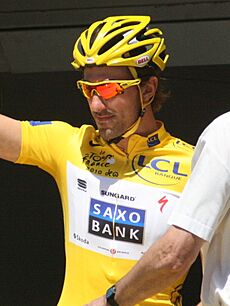
The most important jersey is the yellow jersey (maillot jaune in French). It is worn by the rider who has the fastest overall time in the race. The color was chosen because the newspaper that started the Tour, L'Auto, was printed on yellow paper.
After each stage, the riders' times are added up. The rider with the lowest total time gets to wear the yellow jersey on the next day's stage. The person wearing the yellow jersey at the end of the final stage in Paris is the overall winner of the Tour de France.
The Green Jersey (Best Sprinter)
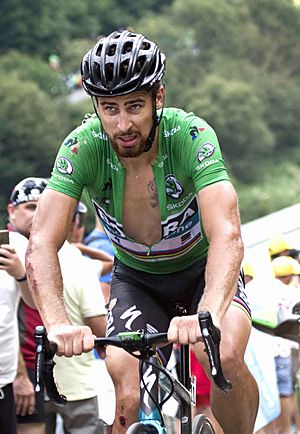
The green jersey (maillot vert) is for the leader of the points classification. Riders earn points by finishing in the top positions at the end of a stage. They can also earn points at special "intermediate sprints" during the stage.
Flat stages offer more points than mountain stages. This means the green jersey is usually won by a sprinter, a rider who is very fast over short distances. Peter Sagan holds the record for winning the green jersey seven times.
The Polka Dot Jersey (Best Climber)
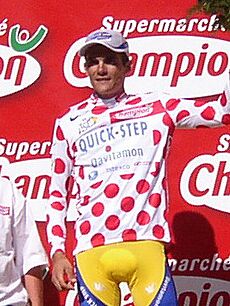
The polka dot jersey (white with red dots) is for the "King of the Mountains." Riders earn points by being the first to reach the top of the mountains on the route.
The mountains are graded from Category 4 (easiest) to Hors Catégorie (hardest). The harder the climb, the more points are awarded. The rider with the most mountain points wears this jersey. Richard Virenque holds the record with seven "King of the Mountains" titles.
The White Jersey (Best Young Rider)
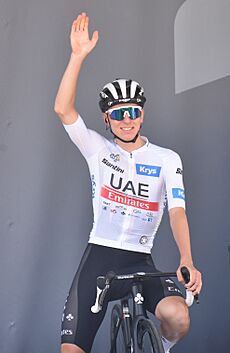
The white jersey (maillot blanc) is for the best young rider. This competition works just like the yellow jersey, but it is only for riders who are under 26 years old.
It gives a chance for young, talented riders to shine. Some riders have won the white jersey and the yellow jersey in the same year, including Tadej Pogačar. He has won the white jersey a record four times.
Types of Stages
The Tour de France is a mix of different kinds of stages, each with its own challenges.
Flat and Hilly Stages
These stages are usually faster and often end with a bunch sprint. All the fast riders, or "sprinters," race to the finish line together at very high speeds. These are the stages where the green jersey contenders try to score points.
Mountain Stages
The mountain stages are often the most exciting and can decide who wins the Tour. Riders must climb steep and long mountains in the Alps and Pyrenees. These stages are for the climbers, who are good at riding uphill. Famous climbs include Alpe d'Huez, Mont Ventoux, and the Col du Tourmalet.
Time Trials
A time trial is a "race against the clock." Each rider starts one by one and races over a set course as fast as they can. The rider with the fastest time wins the stage. Time trials are very important for riders who want to win the yellow jersey, as they can gain or lose a lot of time on their rivals.
The Finish in Paris
Since 1975, the final stage of the Tour has finished on the famous Champs-Élysées in Paris. This stage is usually a celebration for the riders who have completed the three-week race.
While the sprinters still race for the stage win, the overall leader in the yellow jersey usually rides safely in the peloton. It is a tradition that the leader's position is not challenged on the final day.
Fun Facts and Records
- Most Wins: Four riders share the record for the most Tour wins, with five victories each: Jacques Anquetil, Eddy Merckx, Bernard Hinault, and Miguel Induráin.
- Most Stage Wins: Mark Cavendish of Great Britain holds the record for the most stage wins, with 35 victories.
- Youngest Winner: The youngest winner was Henri Cornet, who won in 1904 at just 19 years old.
- Closest Finish: The smallest winning margin was just 8 seconds in 1989, when Greg LeMond beat Laurent Fignon in the final time trial.
- Most Days in Yellow: Eddy Merckx wore the yellow jersey for a record 96 days during his career.
Images for kids
-
The podium of the 1964 Tour de France: Jacques Anquetil (center), Raymond Poulidor (left), and Federico Bahamontes (right).
-
Bernard Hinault on his way to his first of five victories in 1978.
-
Miguel Induráin won the Tour five times in a row from 1991 to 1995.
-
Chris Froome won the Tour four times for Great Britain.
-
Andy Schleck (left) and Alberto Contador (right) were big rivals in the late 2000s.
-
Bradley Wiggins during a time trial in 2012.
See also
 In Spanish: Tour de Francia para niños
In Spanish: Tour de Francia para niños


